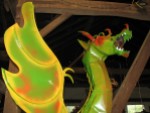Artist Niki de Saint Phalle was born on October 29, 1930 in Neuilly-sur-Seine, France. Her huge sculptures decorate museums and public spaces around the globe. I first met her work in the Fontaine des automates, the Stravinsky Fountain outside the Centre Pompidou in Paris, and recognize her pieces immediately when I encounter them. Saint Phalle collaborated on the creation of the fountain with her husband Jean Tinguely. Her figures aren’t the usual idealized depictions of the female body, and she often addressed current issues. She worked with artists in other mediums as well. Her health was damaged by the materials she used to create her artwork.
She had no formal training but became one of the world’s most important feminist artists. I read that her style is called idiosyncratic ‘outsider art’.
I would simply say, genius. In her honor here’s a post I wrote about a family of artists creating wildly creative work. The Ferros were my dad’s neighbors. – Jadi
My father lived on a very cool street. He had a little place on a small lake. When I visited, I’d spend hours watching critters on and in the water. And then I took a stroll down the road, because Dad had artist neighbors. The Ferros’ artwork decorates the street.




Their home is chock full of art, almost all of it made by Tino and Carole. When Carole kindly gave me a tour of the house, I couldn’t stop taking photographs. Every single inch of space contained something interesting and wildly creative.



The 1920’s home originally belonged to Tino’s parents.
They added on, sourcing materials from old buildings in the area that were being torn down. These ceiling beams came from a church.
They run a gallery, just a few miles away.

Sculptures adorn the outside lawns; here is only a sample.
Two of the couple’s offspring joined them to create the gallery. Ninety percent of the materials they use are recycled or pre-used. The Ferro family also produces smaller pieces, glass work, and paintings. Click on the thumbnail photos for a closer look.
I loved the female figures made of recycled metal strips from factory punches and stamps.

Tino and Carole worked and raised their family in Portugal from 1988-2008. Tino tells me Europeans still collect their art work.
The Ferros run a second gallery in North Carolina. I can only imagine what’s in that one. But I’m sure those neighbors love having Tino and Carole down the street!
Contact info: Frog Pond Studio (South), Metal Scuptures, Furniture: 58 Prairie Lane, St. Pauls, NC 28384. tel: 910 865 4998. cell 910 740 3749. email: cferro2598@aol.com
Frog Pond Farm Folk Art Gallery (North), 5969 Rt. 281, Little York, NY 13087. tel: 607 749 6056
 In memory of Niki de Saint Phalle, 29 October 1930 – 21 May 2002
In memory of Niki de Saint Phalle, 29 October 1930 – 21 May 2002
Text and Photos © 2015 Jadi Campbell. Previously published as Wildly Creative: The Ferros of Little York.
My books are Broken In: A Novel in Stories, Tsunami Cowboys, Grounded and The Trail Back Out.
Click here for my author page to learn more about me and purchase my books.






























































